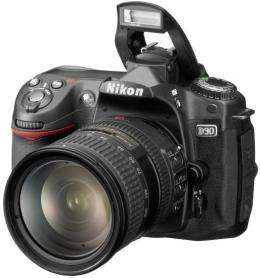Nikon DSLRs can give eye-opening results

I am no camera buff. I bought my first digital camera only three years ago, and I often prefer to use the 2-megapixel camera in my iPhone than carry around another gadget.
But there are situations that call for a real camera, such as a wedding. I've been to two of those in the past four months (my own and my brother's), so I decided to bring a "real" camera along to each.
I'm talking about digital single lens reflex (DSLR) cameras. These cameras will not fit in your shirt pocket, but they will produce stunning, professional-quality photos.
The design allows the user to view directly through the lens for more accurate framing and composition. DSLRs also have swappable lenses, which create wider and brighter pictures than point-and-shoot digital cameras. The lenses also let you control depth of field, and how much of the photo will be in focus, such as people or objects in the foreground.
They're also generally a lot more expensive than point-and-shoot digital cameras. I tested two models from Nikon: the D90 (which came with an 18-105mm VR lens, $1,300) and the D60 (which came with 18-55mm VR lens, $650.)
I used the D90 for my wedding and honeymoon and the D60 for my brother's wedding. The D90 also has the distinction of being the first DSLR camera to shoot high-definition video.
This column isn't a comprehensive review of DSLR cameras but rather a review of two popular models and an attempt to answer the question: Is it worth it to shell out the extra money for a DSLR?
Regardless of which brand or model you get, a DSLR is going to produce dramatically better photos than a point-and-shoot camera, so it's a good investment if you are serious about photography. Yes, you will look like a tourist whenever you use it, but as more people continue trading in their shirt-pocket cameras for DSLRs, you won't stand out as much. Plus, you can still use your shirt-pocket camera.
Both the D60 and the D90 are easy to pick up and start using. There's an autofocus setting so you don't have to study the manual first, and the cameras fit comfortably in your hands. They both have great battery life and will shake dust off the image sensor. The D60 is about 10 percent smaller than the D90. Both come with vibration-reduction lenses, which let me take clear photos while I was moving or shooting a moving subject.
I was blown away by the quality of the D90's pictures and how much fun it was to use the camera. So were other people who borrowed it during my wedding weekend. In truth, I probably used about a hundredth of the features on either camera, but I could still tell the difference. My wife, who doesn't like to spend a lot of money on gadgets, liked the D90 so much that she actually suggested we get one. And we are not the type of people who would normally consider spending $1,300 for a camera.
I liked the D90 better because I could shoot pictures faster (4.5 frames per second vs. 3 frames per second), the resulting pictures were more vibrant, detailed and lifelike and the bigger LCD screen on the back (3-inch compared with 2.5-inch) made showing off my photos a lot easier.
Nikon spokesman Lindsay Silverman attributed some of the differences in the models to the higher resolution (12.3 megapixels vs. 10.2 megapixels) and because the D90 has two features the D60 doesn't: a scene recognition system and facial recognition. When the D90 senses you're taking a picture of someone's face, it automatically makes the necessary adjustments to produce a great picture. Right before you take a picture, the camera draws on a database of more than 30,000 photographic images, and when it finds a similar one, it instantly adjusts the settings accordingly.
The D90 also has more autofocus points (11 vs. 3), which gives you a greater chance for capturing more subjects in focus, regardless of where they are positioned in the frame.
I'm torn about the need for HD video on a DSLR camera. The videos I shot during the day came out really well, and you can actually use the camera's lens to zoom in and out. This is a killer feature if you are shooting video of a sporting event from the stands. But because you have to look through the LCD screen when you shoot video, it isn't as comfortable to hold the camera.
Although I liked the D90 a lot better, the D60 is still a great camera, particularly if you don't want to spend a lot, you want a smaller camera and you don't want to do a lot of tweaking of settings. But for truly out-of-this-world photos and the ability to shoot video, the D90 is worth saving up for.
___
© 2009, The Orlando Sentinel (Fla.).
Visit the Sentinel on the World Wide Web at www.orlandosentinel.com/
Distributed by McClatchy-Tribune Information Services.





















